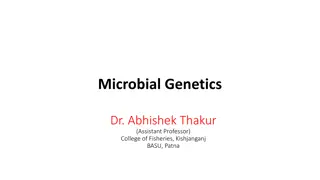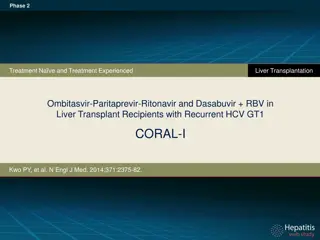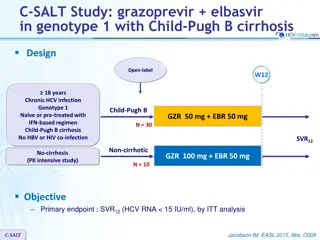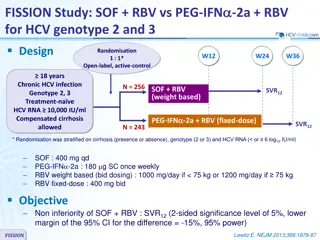Sudden Death and Cardiomyopathy Associated with LMNA in Nova Scotia Duck Tolling Retriever
A study on sudden death and cardiomyopathy in Nova Scotia Duck Tolling Retrievers due to LMNA association. The research includes genetic mapping, genotype verification, and functional predictions on Lamin A/C effects. Echocardiogram findings, pedigree data, genome-wide association study, whole-genom
0 views • 13 slides
Investigating Human Papillomavirus Genomes in Cervical Neoplasms
This project focuses on studying the Human Papillomavirus (HPV) genome's association with disease progression and treatment response in cervical neoplasms and cancer. The research aims to genotype high-risk HPVs in healthy and diseased cervix, identify prevalent genotypes, detect genotype drift, cha
1 views • 13 slides
Genetics: The Blueprint of Life
Genetics is the study of heredity and how traits are passed from parents to offspring. It involves understanding genetic makeup (genotype) and physical attributes (phenotype) determined by genes. Mendel's laws of segregation and independent assortment explain how alleles and traits are inherited. Nu
0 views • 34 slides
Unraveling the Mystery of Traits and Genes
Explore the fascinating world of traits and genes, understanding how they are passed down from parent to offspring through chromosomes. Delve into the role of genes in controlling various traits such as hair color, eye color, and even unique characteristics like detached earlobes and widow's peak. D
0 views • 11 slides
Understanding Genetic Crosses and Inheritance Patterns
Discover the world of genetic crosses through gene diagrams and Punnett squares. Explore the terminology, genotype, phenotype, and the concepts of dominance and recessiveness. Learn how genes control characteristics like eye color, delve into allele combinations for flower color, and see possible ou
0 views • 15 slides
Understanding Evolution by Natural Selection
Explore the concepts of species, mutation, Darwin's theory of evolution, and the role of genetic variation through mutations. Learn how mutations can lead to rapid changes in species and why a wider variety of genes in a gene pool benefits a population. Delve into the effects of mutations on individ
0 views • 15 slides
Production of Haploid Plants: Approaches and Significance
There are two main approaches for haploid plant production - in vivo and in vitro methods. Haploids are important in plant breeding but are rare naturally. Various techniques like androgenesis, gynogenesis, distant hybridization, irradiation, and chemical treatments are used to induce haploid produc
0 views • 4 slides
Understanding Epigenetics: DNA Methylation and Histone Modification
Epigenetics involves modifications that impact gene expression without altering DNA sequences, playing a crucial role in the transition from genotype to phenotype. This includes DNA methylation, histone modification, and microRNAs. DNA methylation, controlled by DNMT enzymes, can lead to either gene
5 views • 12 slides
Understanding Microbial Genetics and Mutations in Organisms
Explore the world of microbial genetics with Dr. Abhishek Thakur, an Assistant Professor specializing in Microbial Genetics at the College of Fisheries, Kishjanganj, BASU, Patna. Learn about important concepts such as strains, clones, genome, phenotype, genotype, genes, genetic recombination, and mu
0 views • 19 slides
Principles of Animal Breeding: Selection and its Basis
Selection in animal breeding involves choosing the best individuals to improve specific traits. Criteria for selection include individual merit, competitive exams, and interviews. Selection of farm animals focuses on non-random reproduction of genotypes. Types of selection include natural and artifi
1 views • 40 slides
Understanding Average Gene Effect and Breeding Value in Animal Genetics
In the field of animal genetics and breeding, it is crucial to comprehend the average effect of genes and breeding value of individuals. Genes are transmitted from parents to offspring through haploid gametes, influencing the genotype and breeding potential. Estimating the average effect of a gene i
5 views • 26 slides
Understanding Dominance in Genetics: The Role of Alleles and Phenotypes
Dominance in genetics refers to the interaction of alleles at the same gene locus. Complete dominance occurs when one allele masks the effect of another in a heterozygous genotype, leading to a phenotype indistinguishable from the dominant homozygote. This concept is crucial for predicting genetic o
1 views • 18 slides
Polymorphism and Variant Analysis Lab Exercise Overview
This document outlines a lab exercise on polymorphism and variant analysis, covering tasks such as running Quality Control analysis, Genome Wide Association Test (GWAS), and variant calling. Participants will gain familiarity with PLINK toolkit and explore genotype data of two ethnic groups. Instruc
0 views • 43 slides
Genotype-Directed Dosing for Efavirenz in Children Study
The study focuses on genotype-directed dosing of Efavirenz in children with HIV, aiming to optimize treatment options and dosages based on genetic factors. It explores the challenges in treating children with HIV, especially in resource-limited settings, and discusses the impact of genetic variation
0 views • 21 slides
Understanding Punnett Squares and Genetic Crosses
Explore the world of genetics through Punnett squares and genetic crosses, where traits like eye color are predicted using Mendel's principles. Discover the laws of dominance, segregation, and how to determine genotype and phenotype ratios in offspring.
0 views • 23 slides
Understanding Hardy-Weinberg Principle and Genetic Frequencies
Gene pool and allele frequencies play a crucial role in the Hardy-Weinberg Principle, a mathematical model predicting allele frequencies over generations. The principle outlines conditions like a large population, absence of mutations, random mating, and more. Equations such as p² + 2pq + q² = 1 h
0 views • 44 slides
Understanding the Importance of Heredity and Genetics
Exploring the essential concepts of heredity and genetics, this content delves into the interplay between nature and nurture, the role of genetic code and DNA, and the mechanisms of inheritance. It highlights how genes influence behavior and the distinction between genotype and phenotype. Through vi
0 views • 21 slides
Understanding Fitness and Evolution Rates in Organisms
Fitness in organisms is crucial for their survival in a given environment. Absolute fitness measures genotype frequencies between generations, while relative fitness compares genotypes to the most successful one. Factors like selection pressure can increase the rate of evolution by promoting benefic
0 views • 14 slides
Statistical and Quantitative Genetics of Disease
This session covers single locus analysis in statistical and quantitative genetics, focusing on design, analysis, logistic regression, covariates, and multivariate analysis. It discusses approaches for analyzing DNA on cases and controls, modeling, and adjusting for covariates. The association analy
0 views • 36 slides
Understanding Genetic Variation and Its Role in Evolution
Genetic variation is crucial for evolution, providing the raw material for adaptation and species diversity. Phenotypic variation can arise from differences in genotype, environment, or their interaction. Studying genetic variation through statistical analysis and at the molecular level helps us unr
0 views • 47 slides
Understanding Genotype and Phenotype in Hereditary Traits
Exploring simple heredity through predicting and modeling phenotypes of Crazy Creatures, students are tasked with contrasting genotype and phenotype. The Crazy Traits lab data table is essential for recording alleles and genotypes, aiding in determining phenotypes for 14 different traits. By complet
0 views • 4 slides
Understanding Genetic Foundations and Protein Production in Biochemistry
Exploring the genetic foundations of biochemistry reveals how organisms evolve through natural selection and how phenotype and genotype are interconnected. The process of gene expression plays a crucial role in determining an organism's phenotype. Additionally, protein production through translation
0 views • 17 slides
Understanding the Red Queen Hypothesis and Coevolution in Host-Parasite Interactions
Exploring the Red Queen Hypothesis, which suggests that coevolution between hosts and parasites maintains genetic variation. Through images and descriptions, this content delves into the intricate dynamics of the evolutionary arms race, where constant adaptation is necessary for survival and the mai
0 views • 8 slides
Understanding Transcription and Gene Expression in Biology
Explore the intricate process of transcription in biology, where mRNA is synthesized from DNA to carry the genetic code for protein production. Learn about the connection between genotype and phenotype, the role of genes in protein synthesis, and the significance of terms such as RNA Polymerase, int
0 views • 16 slides
Understanding Genotype and Phenotype: The Genetic Basis of Organism Variation
Genotype determines the genetic makeup of an organism, while phenotype encompasses its observable traits. Johannsen's theory states that phenotype is a result of genotype, which remains constant throughout life. The concept of phenocopy refers to mimicking another phenotype without altering the geno
0 views • 15 slides
Solving N-Queen Problem Using Genetic Algorithm
Solving the N-Queen problem involves placing queens on a chessboard in such a way that they cannot check each other. The genetic algorithm approach addresses this problem through representations like phenotype and genotype, fitness evaluation based on queen penalties, mutations involving permutation
0 views • 8 slides
Maternal Effect on Shell Coiling in Snails
Maternal effects play a crucial role in determining the coiling direction of snail shells. The maternal inheritance of organelle genes controls certain traits in offspring, with the direction of shell coiling being a classic phenotype exhibiting maternal effects. The genotype of the female parent de
0 views • 7 slides
Exploring Protein Modeling in Sickle Cell Genotype
Dive into the world of protein modeling to understand why some individuals with the sickle cell genotype remain asymptomatic. Explore amino acid sequences, build typical and sickle cell protein segments, and visually represent the changes in protein structure. Hands-on instructions guide you through
0 views • 6 slides
Comparison of Simeprevir vs. Telaprevir in HCV Genotype 1 Non-Responders
The ATTAIN study compared simeprevir and telaprevir in previous non-responders with genotype 1 HCV. The study included 379 patients with simeprevir and 384 with telaprevir, focusing on SVR12 as the primary endpoint. Baseline characteristics, treatment regimens, patient disposition, and virologic out
0 views • 6 slides
Understanding the Flow of Genetic Information
The flow of genetic information involves the transmission of DNA content into specific protein synthesis through the processes of transcription and translation. Genes dictate the traits of an organism by directing the production of proteins, which serve as the connection between genotype and phenoty
0 views • 15 slides
Star-AI for Genetic Data Analysis: Incorporating Knowledge in Statistical Modeling
Knowledge-based approaches are crucial in genetic data analysis to enhance the accuracy and scope of genome-wide association studies (GWAS). Stochastic Relational AI (Star-AI) offers a solution by leveraging probability theory and First Order Logic to capture complex genetic interactions. By integra
0 views • 10 slides
Understanding Equilibria in Populations: Hardy-Weinberg Principle
Exploring the concept of equilibria in populations, focusing on Hardy-Weinberg principles and its implications. The discussion covers allele distributions, genotype frequencies, maintenance of equilibrium across generations, and scenarios where equilibrium may be violated. Key points include basic p
0 views • 58 slides
C-EDGE.TN Study: Grazoprevir/Elbasvir in Genotype 1, 4, or 6 - Treatment for HCV Infection
The C-EDGE.TN Study evaluated the efficacy of grazoprevir/elbasvir treatment in patients with HCV infection, specifically genotype 1, 4, or 6. The study included 316 patients and aimed to achieve SVR12 rates superior to historical standards. The treatment was well-tolerated, with high SVR12 rates ac
0 views • 9 slides
Efficacy of Ombitasvir-Paritaprevir-Ritonavir and Dasabuvir with Ribavirin in Liver Transplant Recipients with Recurrent HCV GT1
The CORAL-I trial evaluated the safety and efficacy of the 3D regimen (ombitasvir-paritaprevir-ritonavir + dasabuvir) combined with ribavirin for 24 weeks in liver transplant recipients with recurrent HCV genotype 1. The study included treatment-naive individuals after transplantation, with specific
0 views • 8 slides
Study on Grazoprevir and Elbasvir in Genotype 1 with Child-Pugh B Cirrhosis
The C-SALT study evaluated the efficacy of grazoprevir and elbasvir in patients with genotype 1 chronic HCV infection and Child-Pugh B cirrhosis. The primary endpoint was achieving sustained virologic response at 12 weeks. The study included treatment-naive and pre-treated patients with IFN-based re
0 views • 7 slides
Effectiveness of Daclatasvir and Sofosbuvir in HCV Genotype 3: Insights from ALLY-3 Study
Study on the efficacy of Daclatasvir and Sofosbuvir in treating Hepatitis C Virus (HCV) Genotype 3, involving treatment-naive and treatment-experienced patients. The Phase 3 trial showcased promising results in achieving SVR12, with detailed patient characteristics, drug dosing, and baseline charact
0 views • 10 slides
Comparison of SOF+RBV vs PEG-IFN-2a+RBV for HCV Genotype 2 and 3 Treatment
FISSION Study compared the efficacy of SOF+RBV and PEG-IFN-2a+RBV for HCV genotypes 2 and 3 in treatment-naive patients with chronic HCV infection. The study included 256 participants in the SOF+RBV group and 243 in the PEG-IFN-2a+RBV group. The primary objective was to determine the non-inferiority
0 views • 6 slides
Simeprevir Combination Therapy in Treatment-Naïve HCV Genotype 1 Patients: QUEST-1 Trial Results
The QUEST-1 trial evaluated the efficacy and safety of simeprevir in combination with peginterferon and ribavirin versus peginterferon and ribavirin alone in treatment-naïve patients with chronic HCV genotype 1 infection. The study showed a significantly higher proportion of patients achieving sust
0 views • 14 slides
Simeprevir Treatment in HCV Genotype 1: ASPIRE Trial Results
The ASPIRE trial evaluated simeprevir treatment in patients with treatment-experienced chronic HCV genotype 1 infection. The study design included different dosing regimens of simeprevir with peginterferon and ribavirin, compared to placebo. Results showed varying sustained virologic response rates
0 views • 9 slides
Understanding Genotype and Phenotype in Genetics
Genotype refers to the genetic code responsible for specific traits, while phenotype is the outward appearance and characteristics of an organism. Traits can be dominant or recessive, with alleles representing the possible choices for a characteristic. Genotypes consist of two letters, one from each
0 views • 7 slides







































